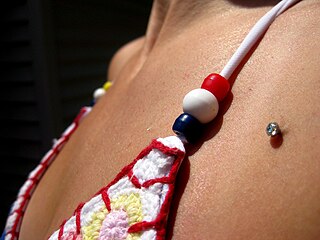
The Bartholin's glands are two pea-sized compound alveolar glands located slightly posterior and to the left and right of the opening of the vagina. They secrete mucus to lubricate the vagina.

Transdermal implants, or dermal piercings, are a form of body modification used both in a medical and aesthetic context that, in contrast to subdermal implants, consist of an object placed partially below and partially above the skin, thus implanted transdermal. Two techniques are prevalent using post-like and microdermal implants respectively.
Vaginoplasty is any surgical procedure that results in the construction or reconstruction of the vagina. It is a type of genitoplasty. Pelvic organ prolapse is often treated with one or more surgeries to repair the vagina. Sometimes a vaginoplasty is needed following the treatment or removal of malignant growths or abscesses to restore a normal vaginal structure and function. Surgery to the vagina is done to correct congenital defects to the vagina, urethra and rectum. It may correct protrusion of the urinary bladder into the vagina (cystocele) and protrusion of the rectum (rectocele) into the vagina. Often, a vaginoplasty is performed to repair the vagina and its attached structures due to trauma or injury.

The rectouterine pouch is the extension of the peritoneum into the space between the posterior wall of the uterus and the rectum in the human female.

Paracentesis is a form of body fluid sampling procedure, generally referring to peritoneocentesis in which the peritoneal cavity is punctured by a needle to sample peritoneal fluid.
ICD-9-CM Volume 3 is a system of procedural codes used by health insurers to classify medical procedures for billing purposes. It is a subset of the International Statistical Classification of Diseases and Related Health Problems (ICD) 9-CM. Volumes 1 and 2 are used for diagnostic codes.

In biology, a lumen is the inside space of a tubular structure, such as an artery or intestine. It comes from Latin lumen 'an opening'.

Natural orifice transluminal endoscopic surgery (NOTES) is a surgical technique whereby "scarless" abdominal operations can be performed with an endoscope passed through a natural orifice then through an internal incision in the stomach, vagina, bladder or colon, thus avoiding any external incisions or scars. Memic's hominis robotic system is the first and only FDA-authorized surgical robotic platform for NOTES procedures. The system is currently at use for transvaginal hysterectomies through the rectouterine pouch - the removal of the uterus, along with one or both of the fallopian tubes and ovaries, in cases where there is no cancer present, as well as with the removal of ovarian cysts

The rectouterine fold is a bilaterally paired prominent ridge/fold of the peritoneum that represents the lateral boundary of the rectouterine pouch on either side. It is formed by the underlying rectouterine muscle. On either side, the rectouterine fold extends between the sacrum medially, and the base of the broad ligament of the uterus laterally.

In human female anatomy, the vesicouterine pouch, also uterovesicle pouch, is a fold of peritoneum over the uterus and the bladder. Like the rectouterine pouch, it is a female pelvic recess, but shallower and closer to the anterior fornix of the vagina.

Retropubic space is a potential avascular space located between the pubic symphysis and the urinary bladder. The retropubic space is a preperitoneal space, located behind the transversalis fascia and in front of peritoneum.

The rectovesical pouch is the pocket that lies between the rectum and the bladder in males in humans and other mammals. It is lined by peritoneum.
The extraperitoneal space is the portion of the abdomen and pelvis which does not lie within the peritoneum.

The uterosacral ligaments are major ligaments of uterus that extend posterior-ward from the cervix to attach onto the sacrum.

A pelvic examination is the physical examination of the external and internal female pelvic organs. It is frequently used in gynecology for the evaluation of symptoms affecting the female reproductive and urinary tract, such as pain, bleeding, discharge, urinary incontinence, or trauma. It can also be used to assess a woman's anatomy in preparation for procedures. The exam can be done awake in the clinic and emergency department, or under anesthesia in the operating room. The most commonly performed components of the exam are 1) the external exam, to evaluate the vulva 2) the internal exam with palpation to examine the uterus, ovaries, and structures adjacent to the uterus (adnexae) and 3) the internal exam using a speculum to visualize the vaginal walls and cervix. During the pelvic exam, sample of cells and fluids may be collected to screen for sexually transmitted infections or cancer.
Culdoscope is an instrument, a kind of endoscope, used to visualize female pelvic organs, introduced through the vagina into the cul-de-sac. The procedure of inserting the culdoscope into the rectouterine pouch is termed culdoscopy.

Culdoscopy is an endoscopic procedure performed to examine the rectouterine pouch and pelvic viscera by the introduction of a culdoscope through the posterior vaginal wall. The word culdoscopy is derived from the term cul-de-sac, which means literally in French "bottom of a sac", and refers to the rectouterine pouch.
A Dolichodouglas is the medical term describing an abnormally profound Douglas' pouch. It may be congenital or acquired. The increased depth of the Douglas' pouch brings it in close anatomical contact with the posterior vaginal wall. Therefore, intestinal loops may apply pressure to this wall, causing a condition known as enterocele, which presents as an outpouching on the posterior vaginal wall. This can be felt and seen during pelvic exam.

In medicine, sampling is gathering of matter from the body to aid in the process of a medical diagnosis and/or evaluation of an indication for treatment, further medical tests or other procedures. In this sense, the sample is the gathered matter, and the sampling tool or sampler is the person or material to collect the sample.












